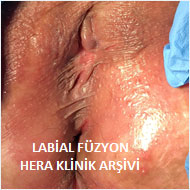Labial fusion is the condition of the inner genital lips (labia minora) sticking together, also known as "labial adhesion" or "labial synechiae". Although it can mostly be seen in early infancy or childhood, it can sometimes develop in the reproductive age and post-menopausal period. In this article, you will find answers to frequently asked questions such as "Why does labial fusion occur, how often does it occur, how to diagnose it in infancy, childhood, and menopause, and how is the treatment of labial fusion and genital area adhesions?"
What is labial fusion?
The lips in the genital area are called "labia’’. Labia are divided into inner (small) lips and outer (large) lips. “Fusion” means contraction, cohesion, adhesion. “Labial fusion” is the name given to the mutual adhesion of the inner genital lip structures in women. In addition, the words "synechia" and "adhesion" are also used in the sense of cohesion. The word "agglutination" means clustering, aggregation.
Thus, the words “labial fusion” and “labial synechia”, “labial adhesion”, and “labial agglutination” all mean the adhesion of the lips in the genital area.
To summarize the terminology;
- Labia: 'lips' in the genital area
- Fusion: adhesion, merging
- Synechia / Adherens: Adhesion, cohesion
- Agglutination: Clustering, coalescence
What kind of problems does it cause?
Since the labia minora (inner lips) surround the vaginal entrance, urinary tract (urethra) outlet, and the clitoris, problems may arise due to the closure of these structures in the case of labial fusion. Fusion sometimes occurs “completely”, sometimes “partially”. Depending on the type of fusion, patients sometimes have no symptoms, and sometimes they can apply to health institutions with severe symptoms.

Causes of Labial Fusion
Although the answer to this question is not known, some mechanisms are emphasized. Among the most accepted causes of labial fusion are “hypoestrogenism”, that is, low estrogen level, chronic irritation, and inflammation. Chronic irritation of the genital area is among the most common causes of labial synechia.
Among the causes of chronic irritation are:
- Recurrent internal and external genital infections
- Constant repetition of allergic conditions (prevalent in women with allergies)
- Constant washing of the external genital area with soap or chemical disinfectants, especially by obsessive people
- Using pads that are not suitable for the body and cause dermatitis (Some pads may not be suitable for some women)
Labial adhesions in infants
Labial adhesions are most commonly diagnosed around three months of age, that is, in infancy. This is because babies are affected by the mother's hormones while in the womb; that is, they are in an environment with intense estrogen. Therefore, labial adhesions are not encountered in the neonatal period. However, labial synechiae may also occur, especially after the second month, when the levels of these hormones in the baby's body decrease.
So, if the estrogen level of every baby girl born drops after birth, why does this happen in a very small proportion of babies and children? Are there other factors that trigger synechia and facilitate its formation?
Conditions such as “diaper dermatitis”, skin infections due to diapers, excessive irritation of the genital area, or inadequate cleaning can trigger labial adhesions. In some patients, no cause can be identified.
What is the incidence in infants?
The incidence of labial fusion in infants is between 0.6-3%.
What are the symptoms of labial fusion?
Some of the labial fusion patients are completely asymptomatic; that is, they do not show any symptoms and are discovered incidentally during routine examinations. Most young girls or women are unaware of their genital adhesions. These are usually patients with partial adhesions in the genital area. If the amount of adhesion increases and full adhesion develops on the inner lips, the symptoms increase, and the complaints increase in parallel.
Diagnosis of Labial Fusion
The diagnosis of labia fusion is based on gynecological examination of the genital area. In the gynecologist examination, the inner lips are shrunken and adhered. The vaginal entrance area has also narrowed. In cases of inner lip adhesion accompanied by lichen sclerosus disease, the entire genital area (large lips, perineum, and clitoral area) may be indistinct and flattened.
Complaints and Complications of Labial Synechia
The most common complaints in labial synechia are frequent urinary tract infections and frequent vaginal infections. The part where the synechia takes place becomes a pocket and can lead to the accumulation of urine after urination and the growth of microbes in this area. This can cause frequent infections, bad odor, and vaginal discharge.
Another complaint in labial synechiae is dripping after urination. The dripping of urine on underwear after going out of the toilet is due to the flow of urine accumulated in the blind pocket caused by the adhesion. In addition, complaints such as deviation of urine flow into the bowl, splashing of urine in different directions, and difficulty urinating can be observed.
When the level of labial adhesion (synechia) is severe, much worse complications such as urine accumulation in the bladder due to inability to empty the urine and leakage of urine to the kidney (vesicoureteral reflux) may occur. Intervention in labial synechiae also depends on the severity of the situation.
On the other hand, depending on the degree of adhesion, it can lead to sexual complaints such as the inability to have sexual intercourse or painful sexual intercourse.
Those with labial synechia problems may also experience the problem of not being able to insert a tampon during their menstrual period. In addition, the structure of the genital area deteriorates over time, and this situation can negatively affect the psychology of the patients in aesthetics.
At what ages is labial fusion more common?
There are two periods in which labial fusions are most common: infancy/childhood, called the "prepubertal" period, and the postmenopausal period.
Labial fusion during menopause
The main reason for labial fusion that occurs during menopause is “hypoestrogenism”, that is, the low estrogen level that occurs with menopause. However, with advancing age;
- Decreased self-care
- Having chronic diseases (such as diabetes)
- Recurrent genital tract infections
- The decrease in the frequency of sexual intercourse
also provide a favorable environment for the formation of labial fusion.
Among the labial fusion symptoms that occur during menopause;
- Inability to urinate
- Frequent urinary tract infections
- Post-void dribbling
- Frequent vaginal infection
- Inability to have sexual intercourse
- Painful sexual intercourse (dyspareunia)
In which diseases are labial synechiae seen?
Labial synechiae are frequently associated with chronic and inflammatory diseases of the genital area, especially in the adult age group.
Among the diseases that can cause labial synechia;
- Frequent vaginal infections
- Lichen sclerosus disease
- Lichen planus disease
- Behçet's syndrome
- Genital area cancers
- Radiotherapy for cancer treatment
- Female genital mutilation
- Vulvectomy operations (removal of this region due to external genital region cancers)
- Vulvar psoriasis (psoriasis in the genital area)
- Genital eczema
- Stevens-Johnson syndrome
What is lichen sclerosus disease?
Lichen sclerosis is an autoimmune disease which can cause itching in the genital area, thinning of the skin, sometimes bleeding, and serious adhesions over time. As in all chronic inflammatory diseases, substances such as “cytokines” secreted by inflammatory cells attacking the area of the disease cause an increase in inflammation.
There may be a risk of closure of the vaginal canal due to almost complete genital adhesions in patients with lichen sclerosis. If these genital adhesions make it difficult to urinate and make sexual intercourse almost impossible, it affects the patients' quality of life very badly if they are not treated.
Treatment of Labial Fusion
There are some determining factors for labial fusion treatment. These are:
- Patient's age
- The severity of complaints due to labial fusion
- Whether there is another concomitant disease
- Severity of labial fusion
Labial Fusion Treatment During Infancy and Childhood
There are different opinions about labial fusion treatment in infancy and childhood. While some studies argue that there is no need for treatment unless there are complaints and most of them heal spontaneously, some studies argue that treatment should be done in the early period even if there is no complaint.
Among the most commonly used methods in the treatment of labial fusion in childhood;
- Opening the lips manually by pulling with hand
- Estrogen cream treatments
If urination is difficult, adhesions are opened by pulling the lip parts by hand. The manual opening method is seen as the most reliable and has no side effects. After this procedure, estrogen-containing cream treatment is given for 1-3 weeks. It is also recommended to use vaseline for 4-6 months after estrogen cream treatment.
Creams containing cortisone can also be used for the treatment of labial synechia.
Although estrogen creams are an effective treatment method, they can cause unwanted side effects. Darkening in the genital area, breast enlargement, and hair growth in the genital area are some of these side effects.
In our personal opinion, in childhood or infancy, if there is no complaint, such as difficulty in urination, there is no need for manual opening treatment. Regardless of which method is used, adhesions may recur in half of the patients after opening the labial fusion. For this reason, postponing the treatment until puberty is seen as a more appropriate option for those who do not have any complaints. With the transition to adolescence, the adhesions of the inner lip in the majority of children open spontaneously.
Treatment Methods of Genital Adhesions During Menopause
Surgical methods are considered in the first line for the treatment of genital adhesions during menopause. The use of estrogen-containing creams before and after the procedure is important in not recurring adhesions. In addition, factors that facilitate genital adhesions such as poor hygiene, substances that cause chronic irritation, and recurrent vaginal infections should also be eliminated. Blood sugar levels should be regulated in diabetic patients. Having regular sexual intercourse is also important in preventing the recurrence of adhesions.
If there is a suspicion of lichen sclerosus disease in genital area adhesions that occur during menopause, a biopsy is taken for a definitive diagnosis.
The vaginal entrance is surgically opened in cases that narrow the vaginal entrance and cause painful sexual intercourse or inability to have sexual intercourse. The vaginal entrance can be widened by removing the tissue stiffness that causes vaginal stenosis. This surgical method, a kind of "perineoplasty" surgery, is also called the "Fenton’s procedure".
Treatment methods of Genital Adhesions in our Clinic
Among the genital adhesion treatment methods that we apply in our clinic, some additional methods are also used besides the classical methods.
The treatment methods we apply;
- Surgical opening of genital area adhesions
- Genital PRP
- Vaginal carbon dioxide laser treatments
- Genital radiofrequency treatments
Genital PRP, vaginal laser, and radiofrequency treatments are continued in sessions at regular intervals depending on the situation. With these methods, the recurrence of genital adhesions can also be prevented.
We also support our patients with pelvic rehabilitation exercises so that the genital lips (labia minora) do not fuse again and the labial fusion problem does not recur. We can also apply hormonal support treatments in a controlled manner.
Treatment of patients with inflammatory processes such as “lichen sclerosus” and “hyperplastic vulvar dystrophy” is important. The treatments applied in these diseases manifesting themselves with periodic exacerbations are according to the patients' complaints. In cases such as not having sexual intercourse or having in a complicated way, the problems can be resolved by surgically widening the vaginal entrance.
Cortisone creams can also be prescribed to these patients to prevent re-adhesion after surgery. In advanced lichen patients, a kind of stem cell treatment SVF (Stromal Vascular Fraction) treatment can also be applied. In lichen patients whose inflammation is under control, no complaints may be observed for years.
Early diagnosis and treatment of patients with labial fusion and genital adhesions are important. For this reason, it is recommended that people who notice anatomical changes in their genital area should not be late for a gynecologist consultation.




